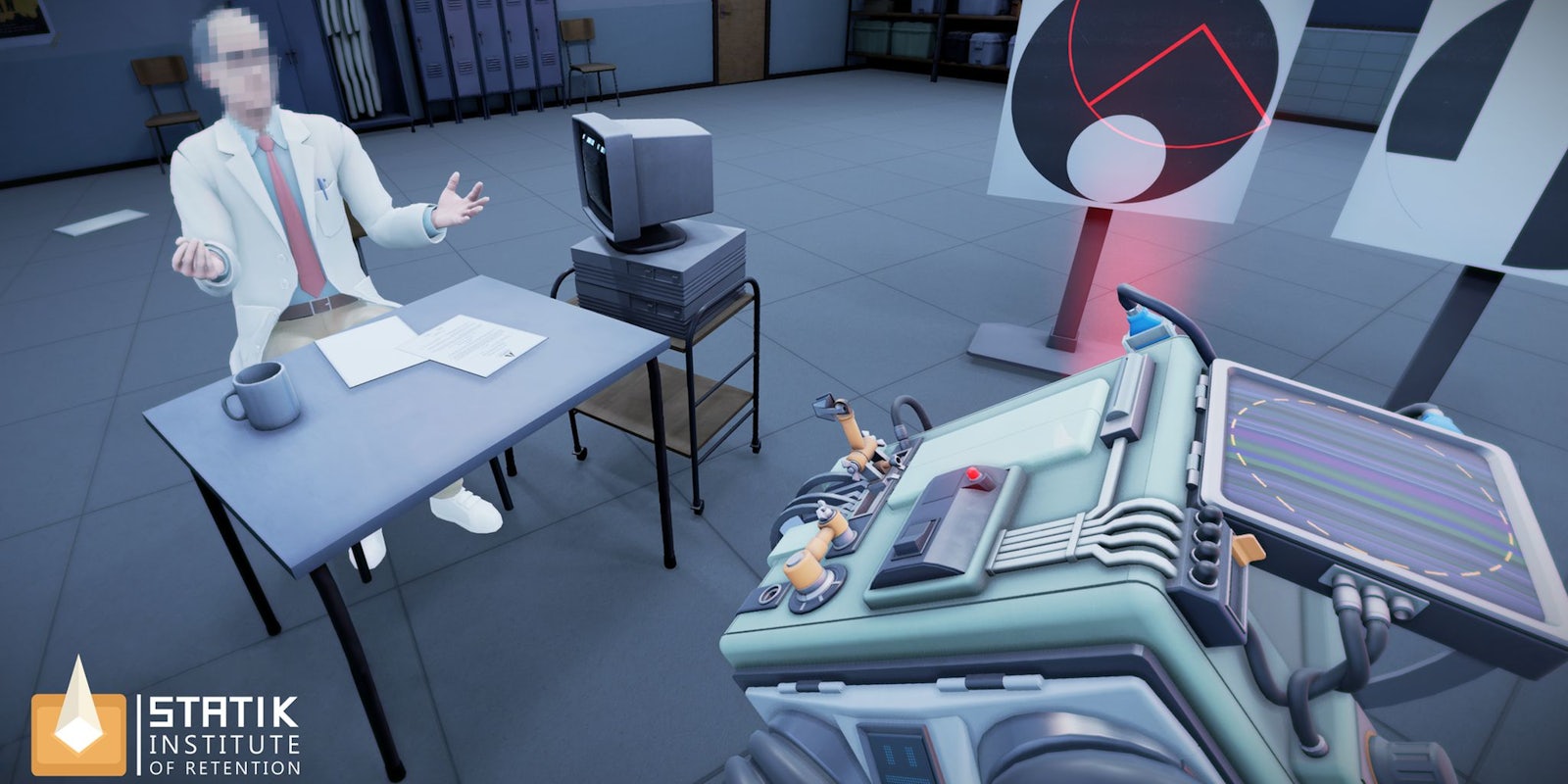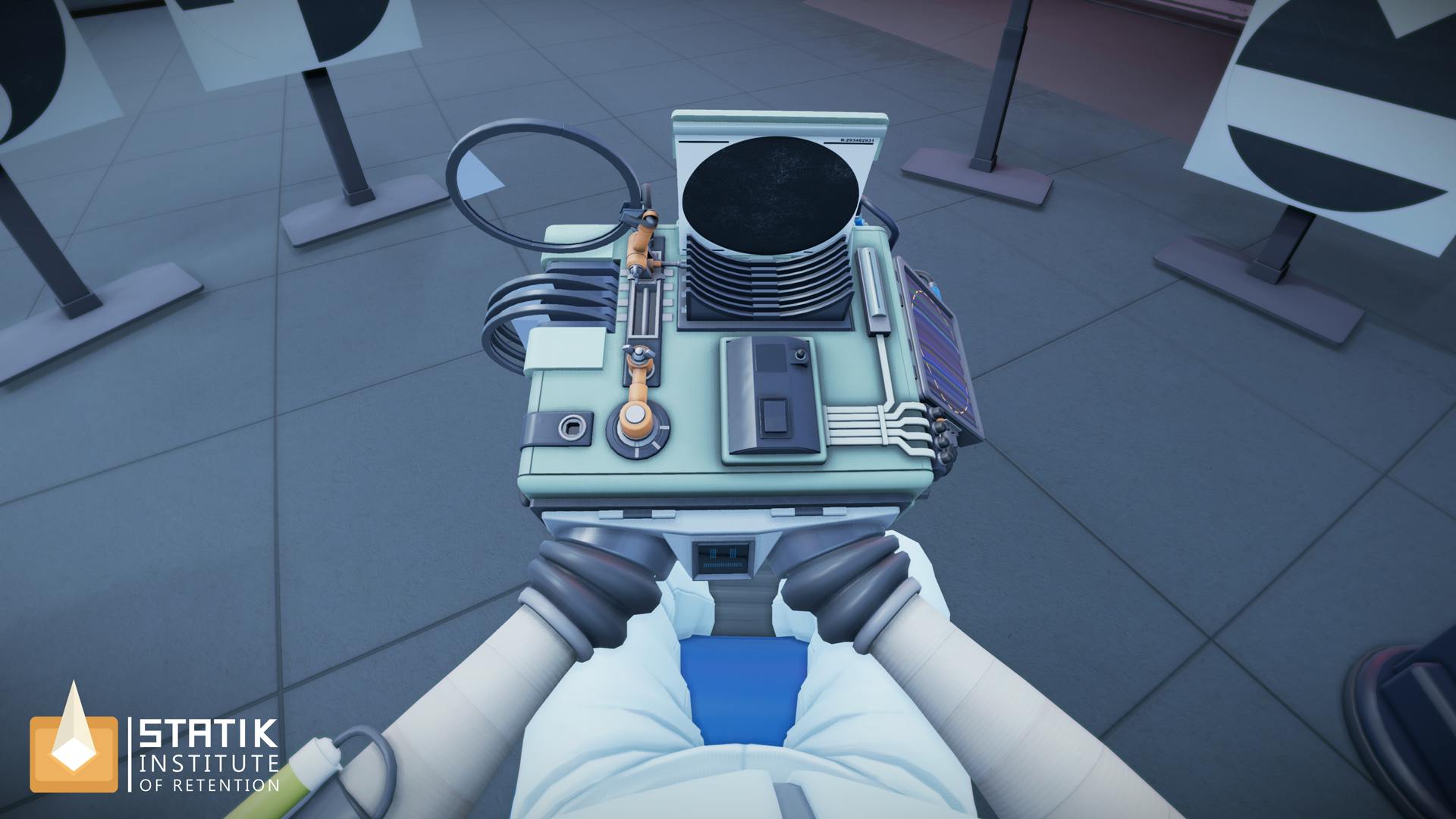My hands had been stuck in the box for more than 20 minutes as I flailed about, trying to figure out which of the dozen switches and buttons would lead to my freedom.
Statik Institute of Retention is one of the few virtual reality gaming demos I can’t seem to get out of my head. It’s a seated experience on PlayStation VR that incorporates the DualShock 4 controller. You are a test subject seated in the middle of what looks a medical examination room. The floor and walls are tiled and painted a dull blue-grey color. An array of bright lights shine down from the ceiling. White lab coats are hung inside a locker against the wall.
You’re surrounded by four signs with strange looking shapes, and your hands are encased up to your wrists in a metal box that’s covered in switches and levers. Some of the buttons control an armature that looks like the arm that picks up records and drops them on the turntable in old jukebox machines.
To free yourself from the box, you have to use the armature to drop lenses in front of a slide projector in the box to project the right shapes onto the four signs in the correct order. A scientist is seated to your left, his face blurred and pixilated to hide his identity. He makes sarcastic remarks as he observes you fumbling for the solution to the puzzle.
If you do free yourself from the puzzle box, the next day you wake up in the lab with your hands encased in a different puzzle box, while the scientist continues to throw strange and unsettling comments in your direction.
I gave up after 15 minutes or so, with the excuse that I didn’t want to hog the demo station all to myself any longer. The truth is that I was getting frustrated, feeling a little hopeless, wanting to get my hands out of the damned box and just couldn’t. My reaction to the quiet, abject horror of being trapped is precisely what Tarsier Studios, the developer of Statik Institute of Retention, was trying to get out of me.
I spoke with Dave Mervik, narrative designer, about how Tarsier Studios—known for making cute Little Big Planet games—pivoted to a horror title, the origins of the Statik project, and coming up with game ideas that only virtual reality can support.
Where did the inspiration for Statik come from?
Andreas Johnsson [co-founder of Tarsier Studios] sat there with a DualShock 4 in his hand just looking around and rotating it, pressing everything, going, “What can I do with this?” And then he was like, “Hmm. We should make a game where that’s exactly what the player will do. Just explore it and not feel that stress really to complete things in time. It’s just, “Ah, look what I can do there.” It just opens up and it changes the pace and it changes the feel of the game.
When did you start thinking about doing something in VR?
Well, there’s a few guys in the office, when the Oculus came out they [would] bang on it, because it’s new technology and that’s one thing Tarsier loves, is getting hold of new technology and designing games around that. So this was designed around the PlayStation VR and the DualShock 4 and what that can do. Because I think that makes it really special on account of [being] a unique experience rather than making something kind of broad and generic that would work across all platforms.
So yeah, I think as soon as we got hold of [PlayStation VR] it was just like, “What can this do? What can we do with this that we can’t do with anything else?”
Was that the first idea that you lit upon? Or did you consider other ideas, first?
I couldn’t tell you, to be honest. What I would say about this is that it did actually begin as more of a horror-ish title. It was the same game, but it was more of a horror setup. And we just weren’t particularly happy with that because you can’t go anywhere else with horror. I mean, you start out in this kind of terrifying scenario, and everything’s scary, there’s nothing else you can do to kind of get the player feeling anything, because they’re just scared all the time.
And what we found, when we switched to this more neutral setting in a lab, then when you go slightly sinister, the player feels it a lot more, because it’s off with the tone that you’ve set at the beginning. So that worked for us.
Were there any things you wanted to do that you couldn’t justify for the return on investment of development time? Things you didn’t have the resources for? I’m trying to get a feel for how developers that are fresh to VR decide what projects to work on, considering the tech is so new, and they have no prior experience with it.
I think I know what you mean…and I think what we’ve done with Statik is this kind of design around where the technology is right now. And as you can see, you sat down, it’s better that you just kind of sat still. It’s all about the controller and the device.
So, from a narrative point of view, that was my starting point. Let’s make that a non-issue. So the whole setup is you sat in a chair, you’ve got a unit on your head, and you’ve got a controller in your hand. You’re immersed straight away. There’s no kind of huge leap you have to make. And so I think as the technology develops we will obviously develop the premise and the design alongside that.

